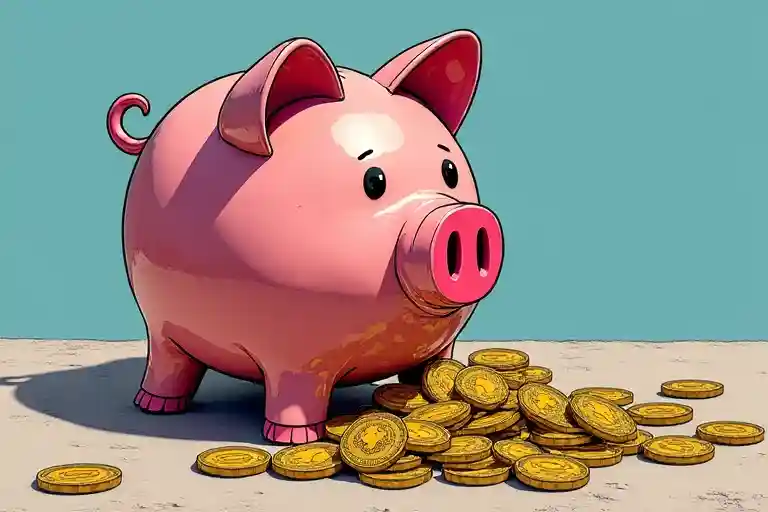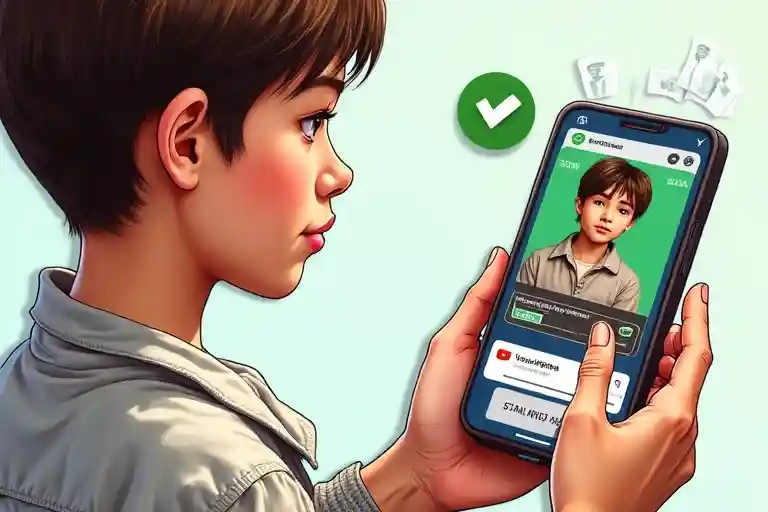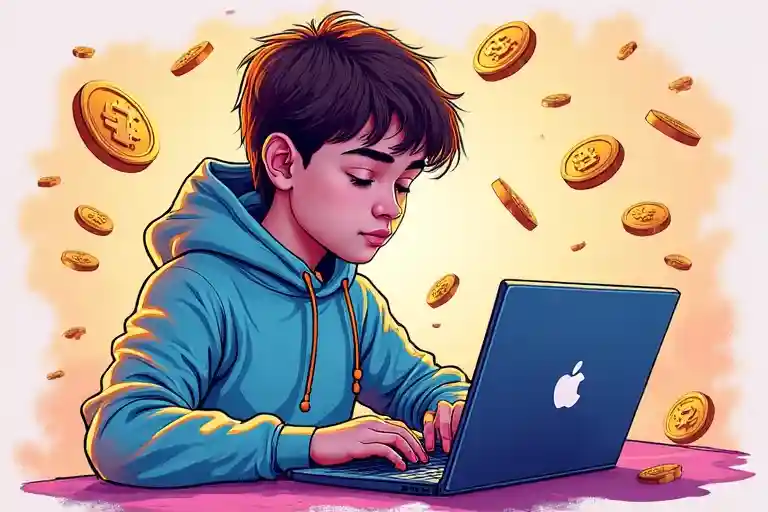Alright, let’s get real for a sec. You’ve probably seen “crypto” popping up EVERYWHERE – TikTok, YouTube, maybe even in your group chats. And then there’s this idea of “crypto earn.” Sounds cool, right? Like, making your digital money make *more* money? But the big question on everyone’s mind, especially if you’re a teen, is: crypto earn worth it? Is it some super-secret way to get rich, or just a lot of hype? And more importantly, how can you even explore it safely if you’re under 18?
Guess what? I was wondering the exact same thing! It’s not just about stacking digital coins; it’s about understanding this wild new world. So, we’re about to dive deep. We’ll break down what crypto earn actually means (no confusing jargon, promise!), explore different ways people try to make their crypto grow, and tackle the elephant in the room – safety, especially for teens. We’ll also get into whether trying to figure out crypto earn worth it is even a good use of your time right now. Spoiler: it’s complicated, but super interesting! We’ll look at some lower-risk ways to learn, like faucets and airdrops, and talk about why your parents *definitely* need to be in the loop. This isn’t about getting rich quick (big red flag if anyone promises that!), but about getting smart. Ready? Let’s go! And hey, if you want to understand more about what crypto income really means, check out our other guide!
Last updated: June 2025
How Does Crypto Earn Actually Work? (No Cap!)
Okay, so “crypto earn” sounds like magic internet money, but what’s REALLY going on? Think of it like this: you know how you can put money in a savings account at a bank, and they give you a tiny bit of extra money (called interest) over time? Crypto earn is kinda similar, but for your cryptocurrencies. Instead of just letting your Bitcoin or Ethereum sit there, “earn” programs offer ways to make them potentially grow. This is a big reason people ask if crypto earn worth it.
These packages commonly contain you lending out your crypto or locking it up for a positive period. In go back, the platform can pay you a reward, usually in the same crypto. It’s like, “Hey, allow us to use your digital cash for a bit, and we’re going to provide you with a few more back as a thanks!” Imagine your buddy wants to borrow your fantastic uncommon gaming pores and skin for every week, and that they promise to give you an additional in-recreation object for letting them. Kinda like that, however with virtual money. But hold up – it’s no longer all sunshine and rainbows, and most of these platforms have strict rules, like being 18 or older. So, for now, think of this as mastering the playbook for a sport you may play later.
Different Ways to Earn: Lending, Staking (The Concepts)
There are some main methods that “serve” things. There is a ** loan **. You lend your crypto on a platform, which then lends it to others (who pay interest). You get a deduction for the interest. It likes to be an ATM, but with more complex terms! Then it’s ** striking **. This is a bit more technical. Some cryptocururrency uses a system called “proof of stake” to protect and run the network. If you own that type of crypto, you can “share” it – basically, lock it to help the network – and earn the price. It’s like being a shareholder who receives a small setback to support the company, but again, to the crypto. Both seem to be cold, but come with risk we will talk soon.
What are “Yields” and “APRs”? (Simplified!)
You’ll hear terms like “APY” (Annual Percentage Yield) or “APR” (Annual Percentage Rate) thrown around a LOT. These basically tell you how much extra crypto you *could* earn over a year. If a platform says “10% APY on CoolCoin,” it means if you put in 100 CoolCoins, you *might* have 110 after a year. (Can you believe it? Sounds awesome, but there’s a catch!) The catch is, these rates can change, and the value of CoolCoin itself could go way up or way down. It’s not like a fixed interest rate at a bank. It’s more like trying to predict if your favorite TikTok sound will still be trending next month – kinda unpredictable! This is a core part of figuring out if crypto earn worth it for your future self.
Is Crypto Earn Safe? The Lowdown for Teens
This is THE most important question, especially for you guys. So, is crypto earn safe? The honest answer: it can be VERY risky. Think of it like skateboarding down a giant hill without a helmet or pads – you *might* make it, but things could go wrong FAST. The whole crypto world is pretty new and not as regulated as traditional money stuff. That means there are more chances for scams, and if something goes wrong, it’s often harder to get help or your money back. You know that sinking feeling when you realize you’ve been had? Like that “expectations vs. reality” meme, but with actual value on the line.
One of the biggest risks is **volatility**. Crypto prices can swing WILDLY. One day your crypto might be worth a lot, the next, not so much. So, even if you’re “earning” more coins, their total dollar value could drop. Then there are platform risks. The place where you’re “earning” crypto could get hacked, or just go out of business. Poof! Your crypto could disappear. It’s like saving all your game progress on a server that suddenly shuts down. FRUSTRATING, and in this case, costly. And remember, if you are looking into finding a legit crypto earning app that’s free to use, always triple-check its reputation and reviews with a trusted adult.
Why Age Restrictions (like 18+) Matter A LOT
Okay, real talk. Almost ALL major crypto earn platforms, like Crypto.com, Binance, Coinbase Earn programs, require users to be 18 or older. There are legal reasons for this, contracts you’re agreeing to, and the understanding of financial risk involved. Trying to get around these rules by, say, fibbing about your age, is a BAAAAD idea. It can get your account shut down, you could lose any crypto you have there, and it’s just not cool. It’s like trying to sneak into an R-rated movie – you might get caught, and it’s not worth the trouble. Respecting these rules is key. For now, your best bet is learning, not trying to actively use platforms you’re not old enough for.
Red Flags to Watch Out For (The “Too Good To Be True” Vibe)
If something sounds WAY too good to be true (like “GUARANTEED 100% returns in a week!”), it probably is. That’s a major red flag. Scammers are all over the crypto space, unfortunately. They might promise huge profits with zero risk. Think of that “Distracted Boyfriend” meme: you, looking at a shiny “super high yield” offer, while common sense (your current girlfriend in the meme) is trying to warn you. Don’t be that boyfriend! Always be skeptical of DMs from strangers offering investment advice, or websites that look shady. Always, always, ALWAYS talk to a trusted adult before even *thinking* about putting any real money (or even significant crypto from faucets) into something.

Crypto Earn vs Staking: What’s the Diff? (Teen Edition)
So you might hear “crypto earn” and “staking” used, and it can get confusing. Are they the same? Not quite! Think of “crypto earn” as the big umbrella category – it’s all the different ways you can potentially grow your crypto holdings. Staking is *one specific type* of crypto earn. It’s like saying “sports” is the big category, and “basketball” is one specific sport you can play. So, all staking is a form of crypto earn, but not all crypto earn is staking. Does that make sense? When people debate crypto.com earn vs staking, they’re often comparing a platform’s general earn program (which might include lending) with the specific act of staking certain coins.
The main difference often comes down to *how* your crypto is being used to generate those returns. With many general “earn” programs on platforms like Crypto.com (again, remembering the 18+ rule!), you might be lending your crypto out. The platform manages this. With staking, *you* are more directly participating in the network of a specific “Proof of Stake” cryptocurrency by locking up your coins to help validate transactions and secure the network. It’s a bit more hands-on with the underlying tech. Both have their own sets of rules, risks, and potential rewards. For teens, understanding the *concepts* is valuable for the future.
What’s Crypto.com Earn (Conceptually, with Age Disclaimers)
When people talk about “Crypto.com Earn,” they’re usually referring to a feature on the Crypto.com platform that allows users (who are 18+) to deposit their crypto and earn interest. They offer different terms (like flexible, or fixed for 1 month or 3 months), and the interest rates can vary depending on the coin and the lock-up period. The longer you agree to lock up your crypto, generally, the higher the potential interest rate. It’s a way for the platform to incentivize users to keep their crypto with them. But again, super important: this is for adults. Knowing how it works is good for your financial literacy, though!
What’s Staking (Conceptually)
Staking, as we touched on, is more specific. It only applies to cryptocurrencies that use a “Proof of Stake” (PoS) consensus mechanism. Think of Tezos, Cardano, or Ethereum (which has moved to PoS). When you stake these coins, you’re essentially helping to run the blockchain. Your staked coins act as a kind of security deposit, showing you have skin in the game. For this service, the network rewards you with more coins. It’s a bit like earning a dividend for being a part-owner who actively helps the company. It’s a core part of how some of the biggest cryptos operate.
Key Differences for Future Reference
So, key differences for when you *are* old enough:
1. **Mechanism:** Earn programs (like on Crypto.com) often involve lending. Staking involves actively participating in a PoS network.
2. **Coin Specificity:** Staking is only for PoS coins. Earn programs can support a wider variety of coins, including those that aren’t PoS.
3. **Control:** With some staking methods, you might have more direct control over your keys (your crypto access), though platform staking can also be an option. Lending through an earn program usually means the platform controls the crypto.
This nuance is part of understanding if crypto earn worth it in different scenarios.
Understanding Crypto Earn Tiers (Like Levels in a Game!)
Okay, so you’re scrolling through info about a crypto earn program (for future reference, of course!), and you see stuff about “tiers.” What’s that all about? Think of it like levels in your favorite video game or a loyalty program at Starbucks. The more you participate or the more you hold of a certain platform’s own crypto token, the better “tier” you might reach. And higher tiers often mean better perks, like higher interest rates on your earned crypto. It’s like unlocking a new skin or a power-up in a game because you’ve put in the effort (or, in this case, the crypto!).
For example, a platform like Crypto.com has its own token called CRO. If users stake (lock up) a certain amount of CRO, they can unlock higher interest rates in their Earn program. So, someone staking zero CRO might get X% on their Bitcoin, but someone staking a LOT of CRO might get X+Y%. It’s a way for these platforms to encourage users to invest in their own ecosystem. This is a common strategy you’ll see, and it adds another layer to figuring out if crypto.com earn tiers make the overall proposition of crypto earn worth it for someone who’s eligible and understands the risks. It’s all about weighing those potential extra rewards against the risk of holding more of the platform’s specific token, which also has its own price volatility.
Using a Crypto Earn Calculator (Conceptually)
So, you see these fancy “crypto earn calculators” online, especially for platforms like Crypto.com. What do they do? Well, they’re supposed to help you estimate how much you *could* potentially earn. You’d typically punch in the type of crypto, the amount you’re thinking of depositing, and maybe the lock-up term. The calculator then spits out an estimate of your earnings over a certain period – daily, monthly, or yearly. It’s like using a mortgage calculator to see how much your monthly payments *might* be, but for crypto gains. A useful internal resource to understand potential earnings is this guide on crypto earnings calculator smart ways.
BUT, and this is a BIG “but” (like, HUGE, underline it, put glitter on it), these are just *estimates*. They often assume the interest rate will stay the same (it might not) and that the price of the crypto will stay the same (it DEFINITELY might not!). It’s a bit like those Instagram filters that make you look like you have perfect skin – it’s an idealized version, not always reality. So, while a crypto.com earn calculator can give you a rough idea, don’t take its numbers as a guarantee. The actual amount you earn could be way different. Always factor in the risks we’ve talked about. It’s a tool, not a crystal ball!

Getting Started with Crypto: Safer Ways for Teens to Explore
Alright, so we’ve established that most big “crypto earn” platforms are for the 18+ crowd. So, what can YOU do if you’re genuinely curious and want to learn about crypto without breaking rules or taking huge risks? Good news! There are ways to dip your toes in, focusing on education and super small amounts. The key here is *learning* and *experimenting safely*, always with your parents’ knowledge and permission. Think of this as the tutorial level of a game – learning the controls before you jump into the main quest.
The goal here isn’t to make bank (you won’t, not with these methods), but to understand how crypto transactions work, what a wallet is, and the general vibe of the space. It’s about getting that hands-on experience in a low-stakes way. This is your foundation for making smarter decisions later if you decide crypto is something you want to be more involved in when you’re older. And honestly, just understanding the tech is a pretty cool skill to have these days! It’s kind of like learning basic coding – even if you don’t become a pro developer, you get how the digital world ticks a bit better.
Learning First! Educational Resources.
Before you even touch a single satoshi (that’s a tiny piece of a Bitcoin!), hit the books – or, you know, the reputable websites and YouTube channels. There are tons of great, free resources out there that explain blockchain, different types of cryptocurrencies, and how it all works in plain English. Look for “.edu” sites, well-known crypto news sites (but be wary of hype!), or even beginner guides from established companies in the space. Think of it as leveling up your knowledge stat first! The more you learn, the better you’ll be at spotting sketchy stuff later on. This is the absolute best first step in figuring out if crypto earn worth it as a field of interest for you.
Parent Power: Why You NEED Your Parents Involved.
This is non-negotiable, fam. Before you sign up for anything, download any app, or even think about getting any crypto, you HAVE to talk to your parents or a trusted guardian. Why?
1. **Safety:** They can help you spot scams or risky platforms. Two heads (especially one with more life experience) are better than one.
2. **Rules & Regs:** They can help you understand any legal or tax stuff (yeah, crypto has taxes eventually if you make real money – something to learn about with our guide on reporting any crypto earnings).
3. **Support:** If something does go sideways, you’ll need their help.
Think of them as your wise Gandalf on this crypto adventure. You wouldn’t want Frodo to go to Mordor alone, right? So, have that chat. Explain you want to *learn* about it safely.
Exploring Teen-Friendlier (Low/No Cost) Avenues
Okay, with parents on board and a good dose of knowledge, here are a few things you *might* explore to get tiny amounts of crypto and learn how things work:
- Crypto Faucets: These are websites or apps that give out super small amounts of crypto for free, usually for completing simple tasks like watching an ad or solving a captcha. The amounts are TINY – like, fractions of a cent. But it’s a way to get your first bit of crypto and learn how to send/receive it to a wallet. For some options, you can check out lists like this one on Top 6 Crypto Faucets. You can also learn more about how crypto faucets can provide free crypto.
- Crypto Airdrops: Sometimes, new crypto projects will “airdrop” free tokens to people to generate buzz. These can be harder to find and vet (lots of scams here too!), but some legitimate ones exist. You might need to perform small social media tasks. Always be super careful and research heavily. Resources like Crypto Airdrops List May 2025 can be a starting point for research, but always with extreme caution and parental guidance. Get more insight on earning free crypto through airdrops.
- Learn-to-Earn Platforms: Some platforms offer small crypto rewards for completing educational modules about cryptocurrency. This is a great way to learn AND get a tiny bit of crypto. Coinbase Earn used to be popular for this (though their main earn programs are 18+). Research if any new, teen-appropriate “learn-to-earn” options are available, always checking terms and age limits.
- Play-to-Earn (P2E) Games (with caution): Some online games incorporate crypto or NFTs, allowing you to potentially earn them through gameplay. The “earn” aspect is often overhyped, and many require an initial investment (which you should avoid). But if there are free-to-start P2E games that seem fun and your parents approve, they can be an interesting way to see crypto in action. Just manage expectations – you’re unlikely to make significant money.
Remember, the goal with these is *education and experience*, not making money. The amounts will be very small. Focus on the process!
So, Is Crypto Earn Worth It for Teens, REALLY?
We’ve hit the big H2, the one that’s probably been on your mind since the start: taking everything into account, is crypto earn worth it for someone your age? The answer isn’t a simple yes or no. It’s more of a “it depends on what you mean by ‘worth it’.” If “worth it” means getting rich quick and buying a Lambo by next Tuesday… then no, absolutely not. That’s pure fantasy, my friend, often peddled by folks who don’t have your best interests at heart. Trying to chase huge returns in crypto as a teen without experience, parental guidance, and often, being underage for platforms, is a recipe for disappointment and potential financial ouchies.
However, if “worth it” means gaining valuable knowledge about a new and evolving financial technology, understanding risks, learning how digital assets work, and maybe, just maybe, earning a tiny bit of crypto through super safe, parent-approved methods like faucets or learn-to-earn programs, then YES, it can definitely be worth your *time and effort* in learning. It’s about the educational journey, not the immediate financial jackpot. Think of it like learning a new language or how to code – it might not make you money tomorrow, but it expands your horizons and skills for the future. That “Aha!” moment when you finally understand a complex crypto concept? That’s a win! And it helps you see if a deeper dive into crypto earn worth it is something for your future self, when you are older and can engage with these platforms responsibly.
Beyond Just Money: What Else Can You Gain? (Knowledge, new skills)
Seriously, the biggest gain for you right now isn’t the pennies from a faucet. It’s the KNOWLEDGE. Understanding blockchain, decentralization, smart contracts (even just the basics!) is like getting a sneak peek into the future of tech and finance. You’ll learn about online security, financial literacy (in a very modern context), and critical thinking (especially when trying to spot scams!). These are skills that are valuable no matter what you end up doing in life. It’s like, by learning about this, you’re upgrading your brain’s software! That’s a pretty cool ROI (Return on Investment) if you ask me.
Time vs. Reward: A Realistic Look for a Teenager’s Schedule.
Let’s be real. As a teen, your time is valuable. You’ve got school, homework, friends, hobbies, maybe a part-time job. Spending hours trying to claim tiny bits of crypto from faucets might not be the best use of that time if your ONLY goal is money. You’d probably earn more from an hour of babysitting or mowing lawns. BUT, if you approach it as “I’m spending an hour this week to *learn* how this crypto stuff works, and hey, I got a few digital cents too,” then the “reward” is the learning itself. So, balance it out. Don’t let crypto exploration take over your life or distract you from more important things. Also, understanding how much you can realistically make from various ventures is key.
When It Might *Not* Be Worth It.
It’s definitely *not* worth it if:
- You’re doing it without your parents’ permission or knowledge. (Big no-no!)
- You’re thinking of putting in real money that you can’t afford to lose (which, as a teen, is probably ANY real money).
- It’s causing you stress or anxiety. (This should be interesting, not terrifying!)
- You’re sacrificing school, sleep, or real-world friendships for it.
- You’re getting drawn into sketchy “get rich quick” schemes. (Remember the “Distracted Boyfriend” meme? Don’t be that guy!)
Basically, if it stops being about learning and starts feeling like a desperate gamble, step away. Your well-being is always #1.
Here’s a quick comparison of some low-risk avenues (always with parental guidance!):
| Method | Potential Earnings | Time Investment | Skill Needed (Initial) | Key Risks (Even if Low) |
|---|---|---|---|---|
| Crypto Faucets | Extremely Low (fractions of cents) | Low-Medium (can be repetitive) | Low (basic internet use) | Time-consuming for tiny rewards, some scammy faucet sites. |
| Airdrops (carefully vetted) | Variable (often low, can be zero, rarely higher) | Medium (research, tasks) | Medium (understanding projects, spotting scams) | Many scams, personal data exposure if not careful, tokens may have no value. |
| Learn-to-Earn | Low (small crypto amounts) | Medium (time for modules) | Low-Medium (reading comprehension) | Platform availability for teens can be limited, rewards are small. |
| Play-to-Earn (Free-to-Start) | Variable (usually very low for free players) | Medium-High (gameplay time) | Medium (gaming skills, understanding game economy) | Time sink, overhyped earnings, potential for game to fail or change rules. |
Level Up Your Safety: Smart Crypto Habits for Teens
Alright, future crypto explorers! Whether you’re just learning now or planning to dive deeper when you’re older, building smart safety habits from DAY ONE is crucial. The crypto world can be like the Wild West sometimes – exciting, full of opportunity, but also with its share of outlaws. So, how do you stay safe and make sure your ventures into understanding if crypto earn worth it don’t end in tears? It’s all about being cautious, informed, and a little bit skeptical (in a healthy way!). Think of it as your personal cybersecurity training montage – getting you ready for the digital frontier.
These habits aren’t just for crypto, by the way. They’re good for being online in general! But they’re *especially* important when there’s potential money (even tiny amounts) involved. Remember that feeling when you accidentally click a bad link? Yeah, we want to avoid the crypto version of that AT ALL COSTS. This is about protecting yourself, your (future) digital assets, and your peace of mind. Let’s get these good habits locked in!
Spotting Scams: The “Nigerian Prince” of Crypto
You’ve probably heard of the “Nigerian Prince” email scam, right? Well, crypto has its own versions. Be super wary of:
- **Guaranteed Profits:** Anyone promising you HUGE returns with NO risk is lying. Crypto is inherently risky.
- **DMs from “Experts”:** Strangers sliding into your DMs offering to manage your crypto or give you “secret” investment tips? BLOCK.
- **Fake Giveaways:** “Send us 1 ETH and we’ll send you 2 ETH back!” It’s a classic scam. They just keep your ETH.
- **Impersonators:** Scammers might pretend to be famous people or support staff from exchanges. Always verify through official channels.
If it feels off, it probably is. Trust that gut feeling! It’s your built-in scam detector.
Protecting Your (Future) Digital Wallet
If you do end up getting a tiny bit of crypto from a faucet or learn-to-earn program (with parental help to set up a simple, beginner-friendly wallet if appropriate), here’s how to think about protecting it:
- **Strong Passwords:** Duh, right? But seriously, use unique, complex passwords for anything crypto-related. And a password manager is your best friend.
- **Two-Factor Authentication (2FA):** Always enable 2FA wherever it’s offered. It’s like having an extra lock on your door.
- **Private Keys are PRIVATE:** If you ever manage your own wallet (more advanced), your private keys are like the keys to your house. NEVER share them with ANYONE. If you lose them, your crypto is gone.
- **Beware of Phishing:** Scammers create fake login pages that look real to steal your info. Always double-check website URLs.
These might seem like a hassle, but they’re SO important.
The Golden Rule: If It Sounds Too Good To Be True…
We’ve said it before, but it bears repeating like your favorite TikTok sound on loop: **If it sounds too good to be true, it almost certainly is.** The crypto space is full of innovation, but it also attracts people looking to make a quick, dishonest buck. There are no shortcuts to wealth, not even with crypto. Healthy skepticism is your superpower here. Always do your own research (DYOR), talk to trusted adults, and never, ever invest (or risk) money you can’t afford to lose. This mindset is key to determining if, for you personally, crypto earn worth it in the long run.
Conclusion
Phew! We’ve covered a TON of ground, haven’t we? From figuring out what crypto earn even *is* to exploring the nitty-gritty of safety and whether crypto earn worth it for a teen like you. The big takeaway? While diving headfirst into complex “earn” programs on major exchanges is mostly an 18+ game, the world of crypto offers HUGE learning opportunities for younger enthusiasts. It’s less about making bank right now, and more about building your knowledge base for the future. Think of yourselves as financial explorers, charting a new, exciting (and sometimes kinda weird) territory!
Understanding concepts like staking, lending, yields, and even how a crypto.com earn calculator *conceptually* works (even if you can’t use it yet) is like getting a superpower in financial literacy. And exploring super low-risk avenues like faucets or learn-to-earn programs – WITH your parents’ full knowledge and guidance – can be a cool way to see crypto in action without any real financial stress. The most important thing is to stay curious, stay Cautious (with a capital C!), and always prioritize learning over earning at this stage. So, is crypto earn worth it? For education and future-proofing your brain? Absolutely! For getting rich quick as a teen? Nah, probably not the path.
Keep Learning & Stay Safe!
What are your thoughts? Got any more questions about crypto earn for teens? Drop a comment below – let’s chat! And hey, if you found this useful, why not share it with your friends on TikTok or Instagram? Spread the knowledge (safely!).
Stay Updated! The crypto world changes FAST – like, new meme trends fast. Keep visiting us here at Zana Website for the latest insights, platform updates, and safety tips. We’re always working to bring you fresh, relevant info!
Frequently Asked Questions
1. Can I make $100 a day from crypto?
For most people, especially teens starting out, making $100 a day from crypto is highly unlikely and often a sign of a risky scheme or scam. Legitimate crypto earning methods usually involve significant capital, high risk, or deep expertise. Focus on learning safely first, not on unrealistic profit promises. It’s important to understand how much you can realistically make before jumping in.
2. Is crypto good for earning?
Crypto *can* be a way to earn, but it comes with substantial risks, especially volatility and scams. For teens, the “earning” should be secondary to learning. Small amounts from faucets or learn-to-earn programs are more about education than income. Always remember that for significant earning, there’s often significant risk and age requirements (18+) for most platforms.
3. Is it worth it to get into crypto?
Getting into crypto *to learn* about the technology and financial innovation can be very worthwhile for teens. It builds knowledge for the future. However, getting into it expecting quick riches or without understanding the risks (and without parental guidance) is not worth it. Approach it as an educational journey, not a guaranteed money-maker to see if crypto earn worth it for you.
4. What is better, crypto earn or staking?
Neither is universally “better”; they are different. “Crypto earn” is a broad term for earning yield, often through lending on platforms. Staking is specific to Proof-of-Stake coins, where you help secure the network. Both have risks and rewards and are generally for users 18+. Understanding the difference is good, but direct participation should wait until you meet age and knowledge requirements.









